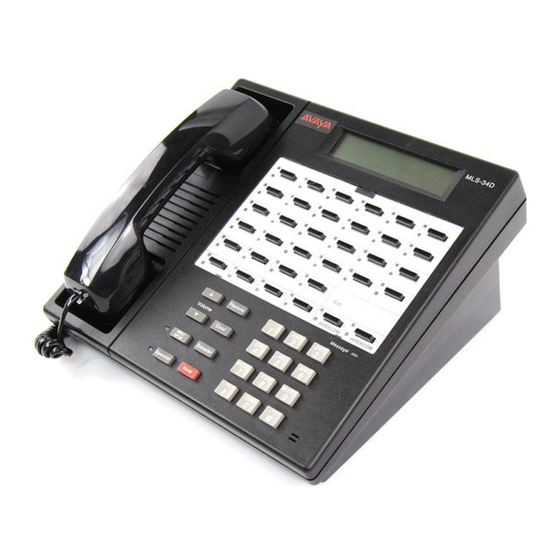
AT&T MLS-34D Manual
Hide thumbs
Also See for MLS-34D:
- Quick reference manual (23 pages) ,
- Manual (9 pages) ,
- Quick reference manual (7 pages)
Table of Contents
Advertisement
Quick Links
Personal Speed Dial Numbers
To dial a Personal Speed Dial number:
See panel 4 for programming instructions. Your system may also be programmed with System Speed
Dial numberes (Dial Codes 20–79), which are similar to Personal Speed Dial Numbers except anyone
on the system can dial them. If programmed, a list is available from your System Manager.
Record your Personal Speed Dial numbers below, in pencil.
DIAL
NAME
CODE
80
81
82
83
84
85
86
87
88
89
System Extensions
EXT
NAME
10
11
12
13
14
15
16
17
18
19
20
21
518-455-252
PARTNER® Plus Communications System Release 3
AT&T
Quick Reference for use with MLS-Series Telephones
Press [
] followed by the Dial Code.
Feature
DIAL
NAME
CODE
90
91
92
93
94
95
96
97
98
99
EXT
NAME
22
23
24
25
26
27
28
29
30
31
32
33
Copyright © 1992 AT&T
Advertisement
Table of Contents

Summary of Contents for AT&T MLS-34D
- Page 1 Personal Speed Dial Numbers To dial a Personal Speed Dial number: Press [ ] followed by the Dial Code. Feature See panel 4 for programming instructions. Your system may also be programmed with System Speed Dial numberes (Dial Codes 20–79), which are similar to Personal Speed Dial Numbers except anyone on the system can dial them.
-
Page 2: Making A Conference Call
Making a Conference Call To add parties to a call (max. 4 parties plus you): 1. Call the first party (can use Speed Dial or Auto Dial buttons). Telephone or 2. After the first party answers, press [ Extension Number + Conf Conf 3. -
Page 3: Telephone Buttons And Indicators
Line/Programmable Buttons A line can be assigned on any button with status lights. (The MLS-34D and MLS-18D have status lights for all of these buttons; the MLS-12D and MLS-12 are identical to the MLS-18D, except that they do not have lights for the 6 buttons above the white line on the right.) When an outside line is assigned, press... -
Page 4: Special Dialing Functions
Programming How to Program Buttons Use programming to store dialing sequences on programmable buttons (see diagram, panels 2–3). Then simply touch the button to dial automatically. Press [ ] to enter program mode. Feature Press a programmable button. Press the buttons you normally press to dial another extension, to dial an outside telephone number, or to use a system feature (see examples below). -
Page 5: Dial-Code Features
Dial-Code Features To Dial To Use On a Dial-Code Feature Button Manually Account Code Entry Dial [ Press the button, Feature Use to enter an account code of up to 16 digits dial the account code, the account code, then for an outside call (incoming or outgoing). - Page 6 Dial-Code Features (continued) To Dial To Use On a Dial-Code Feature Manually Button Group Calling—Ring/Page Ring: [ Press the button Simultaneously rings or pages all extensions in a Intercom + Group Number (1–4) Calling Group.* Begin speaking when you hear a beep;...
-
Page 7: Ringing Patterns
Ringing Patterns You can tell the type of call coming in by the way the phone rings: Ring...Ring...Ring...Ring...Ring...Ring... Outside Call Ring-BEEP...Ring-BEEP...Rinf-BEEP... Inside Call Ring-BEEP-BEEP...Ring-BEEB-BEEP... Transferred Call Lights (top) light shows activity at another extension. Green (bottom) light shows activity at your extension. Steady on: Line is busy. -
Page 8: Transferring A Call
Transferring a Call To pass a call to another extension: While active on the call, press [ Transfer Transfer Extension Number The call is put on hold and you hear intercom dial tone. Dial the extension (or [ ] and a Hunt Group number from 1–6) to which you want the call transferred. - Page 9 Making a Call To call an outside party: If a password is needed, enter it before step 1. Also, to get outside dial Outside: tone, you may have to enter an account code before step 2. ] + Phone Number Line Lift the handset.












Need help?
Do you have a question about the MLS-34D and is the answer not in the manual?
Questions and answers